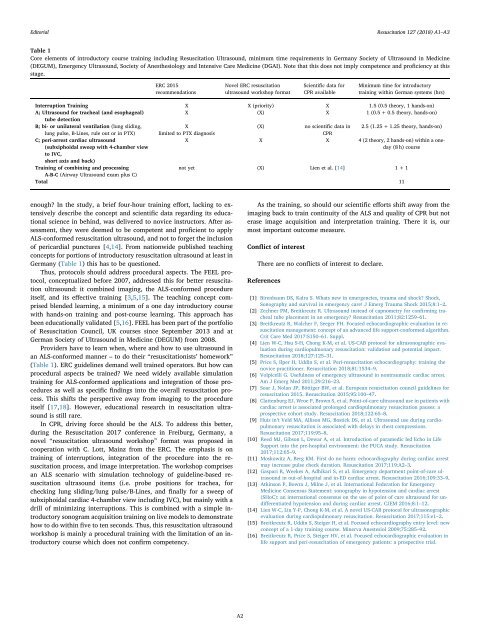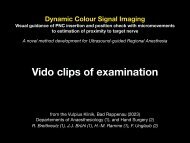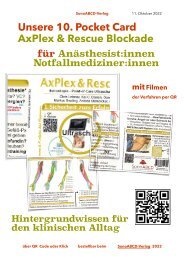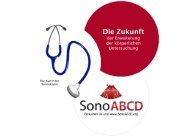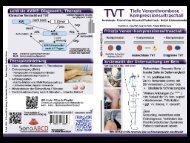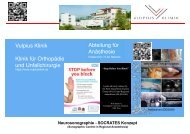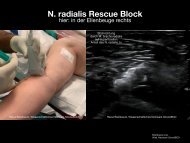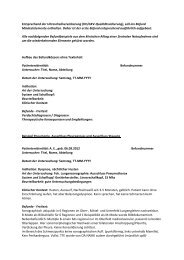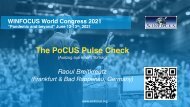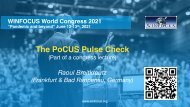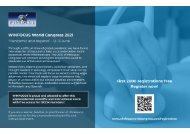Damjanovic D et al. Resuscitation 2018
#This is our latest commentary on resuscitation ultrasound, because of the trial of Lien at al. in the same issue (https://www.resuscitationjournal.com/article/S0300-9572(18)30061-3/pdf). #Hier unsere aktuelle Zusammenfassung zum Thema Reanimationsultraschall aufgrund der Arbeit von Lien et al. in der gleichen Ausgabe der Zeitschrift.
#This is our latest commentary on resuscitation ultrasound, because of the trial of Lien at al. in the same issue (https://www.resuscitationjournal.com/article/S0300-9572(18)30061-3/pdf). #Hier unsere aktuelle Zusammenfassung zum Thema Reanimationsultraschall aufgrund der Arbeit von Lien et al. in der gleichen Ausgabe der Zeitschrift.
Sie wollen auch ein ePaper? Erhöhen Sie die Reichweite Ihrer Titel.
YUMPU macht aus Druck-PDFs automatisch weboptimierte ePaper, die Google liebt.
Editori<strong>al</strong><br />
<strong>Resuscitation</strong> 127 (<strong>2018</strong>) A1–A3<br />
Table 1<br />
Core elements of introductory course training including <strong>Resuscitation</strong> Ultrasound, minimum time requirements in Germany Soci<strong>et</strong>y of Ultrasound in Medicine<br />
(DEGUM), Emergency Ultrasound, Soci<strong>et</strong>y of Anesthesiology and Intensive Care Medicine (DGAI). Note that this does not imply comp<strong>et</strong>ence and proficiency at this<br />
stage.<br />
ERC 2015<br />
recommendations<br />
Novel ERC resuscitation<br />
ultrasound workshop format<br />
Scientific data for<br />
CPR available<br />
Minimum time for introductory<br />
training within German systems (hrs)<br />
Interruption Training X X (priority) X 1.5 (0.5 theory, 1 hands-on)<br />
A; Ultrasound for trache<strong>al</strong> (and esophage<strong>al</strong>)<br />
X (X) X 1 (0.5 + 0.5 theory, hands-on)<br />
tube d<strong>et</strong>ection<br />
B; bi- or unilater<strong>al</strong> ventilation (lung sliding,<br />
X<br />
(X)<br />
no scientific data in 2.5 (1.25 + 1.25 theory, hands-on)<br />
lung pulse, B-Lines, rule out or in PTX) limited to PTX diagnosis<br />
CPR<br />
C; peri-arrest cardiac ultrasound<br />
(subxiphoid<strong>al</strong> sweep with 4-chamber view<br />
X X X 4 (2 theory, 2 hands-on) within a oneday<br />
(8 h) course<br />
to IVC,<br />
short axis and back)<br />
Training of combining and processing<br />
not y<strong>et</strong> (X) Lien <strong>et</strong> <strong>al</strong>. [14] 1+1<br />
A-B-C (Airway Ultrasound exam plus C)<br />
Tot<strong>al</strong> 11<br />
enough? In the study, a brief four-hour training effort, lacking to extensively<br />
describe the concept and scientific data regarding its education<strong>al</strong><br />
science in behind, was delivered to novice instructors. After assessment,<br />
they were deemed to be comp<strong>et</strong>ent and proficient to apply<br />
ALS-conformed resuscitation ultrasound, and not to forg<strong>et</strong> the inclusion<br />
of pericardi<strong>al</strong> punctures [4,14]. From nationwide published teaching<br />
concepts for portions of introductory resuscitation ultrasound at least in<br />
Germany (Table 1) this has to be questioned.<br />
Thus, protocols should address procedur<strong>al</strong> aspects. The FEEL protocol,<br />
conceptu<strong>al</strong>ized before 2007, addressed this for b<strong>et</strong>ter resuscitation<br />
ultrasound: it combined imaging, the ALS-conformed procedure<br />
itself, and its effective training [3,5,15]. The teaching concept comprised<br />
blended learning, a minimum of a one day introductory course<br />
with hands-on training and post-course learning. This approach has<br />
been education<strong>al</strong>ly v<strong>al</strong>idated [5,16]. FEEL has been part of the portfolio<br />
of <strong>Resuscitation</strong> Council, UK courses since September 2013 and at<br />
German Soci<strong>et</strong>y of Ultrasound in Medicine (DEGUM) from 2008.<br />
Providers have to learn when, where and how to use ultrasound in<br />
an ALS-conformed manner – to do their “resuscitationists’ homework”<br />
(Table 1). ERC guidelines demand well trained operators. But how can<br />
procedur<strong>al</strong> aspects be trained? We need widely available simulation<br />
training for ALS-conformed applications and integration of those procedures<br />
as well as specific findings into the over<strong>al</strong>l resuscitation process.<br />
This shifts the perspective away from imaging to the procedure<br />
itself [17,18]. However, education<strong>al</strong> research in resuscitation ultrasound<br />
is still rare.<br />
In CPR, driving force should be the ALS. To address this b<strong>et</strong>ter,<br />
during the <strong>Resuscitation</strong> 2017 conference in Freiburg, Germany, a<br />
novel “resuscitation ultrasound workshop” format was proposed in<br />
cooperation with C. Lott, Mainz from the ERC. The emphasis is on<br />
training of interruptions, integration of the procedure into the resuscitation<br />
process, and image interpr<strong>et</strong>ation. The workshop comprises<br />
an ALS scenario with simulation technology of guideline-based resuscitation<br />
ultrasound items (i.e. probe positions for trachea, for<br />
checking lung sliding/lung pulse/B-Lines, and fin<strong>al</strong>ly for a sweep of<br />
subxiphoid<strong>al</strong> cardiac 4-chamber view including IVC), but mainly with a<br />
drill of minimizing interruptions. This is combined with a simple introductory<br />
sonogram acquisition training on live models to demonstrate<br />
how to do within five to ten seconds. Thus, this resuscitation ultrasound<br />
workshop is mainly a procedur<strong>al</strong> training with the limitation of an introductory<br />
course which does not confirm comp<strong>et</strong>ency.<br />
As the training, so should our scientific efforts shift away from the<br />
imaging back to train continuity of the ALS and qu<strong>al</strong>ity of CPR but not<br />
erase image acquisition and interpr<strong>et</strong>ation training. There it is, our<br />
most important outcome measure.<br />
Conflict of interest<br />
There are no conflicts of interest to declare.<br />
References<br />
[1] Birenbaum DS, K<strong>al</strong>ra S. Whats new in emergencies, trauma and shock? Shock,<br />
Sonography and surviv<strong>al</strong> in emergency care! J Emerg Trauma Shock 2015;8:1–2.<br />
[2] Zechner PM, Breitkreutz R. Ultrasound instead of capnom<strong>et</strong>ry for confirming trache<strong>al</strong><br />
tube placement in an emergency? <strong>Resuscitation</strong> 2011;82:1259–61.<br />
[3] Breitkreutz R, W<strong>al</strong>cher F, Seeger FH. Focused echocardiographic ev<strong>al</strong>uation in resuscitation<br />
management: concept of an advanced life support-conformed <strong>al</strong>gorithm.<br />
Crit Care Med 2017:S150–61. Suppl.<br />
[4] Lien W-C, Hsu S-H, Chong K-M, <strong>et</strong> <strong>al</strong>. US-CAB protocol for ultrasonographic ev<strong>al</strong>uation<br />
during cardiopulmonary resuscitation: v<strong>al</strong>idation and potenti<strong>al</strong> impact.<br />
<strong>Resuscitation</strong> <strong>2018</strong>;127:125–31.<br />
[5] Price S, Ilper H, Uddin S, <strong>et</strong> <strong>al</strong>. Peri-resuscitation echocardiography: training the<br />
novice practitioner. <strong>Resuscitation</strong> <strong>2018</strong>;81:1534–9.<br />
[6] Volpicelli G. Usefulness of emergency ultrasound in nontraumatic cardiac arrest.<br />
Am J Emerg Med 2011;29:216–23.<br />
[7] Soar J, Nolan JP, Böttiger BW, <strong>et</strong> <strong>al</strong>. European resuscitation council guidelines for<br />
resuscitation 2015. <strong>Resuscitation</strong> 2015;95:100–47.<br />
[8] Clattenburg EJ, Wroe P, Brown S, <strong>et</strong> <strong>al</strong>. Point-of-care ultrasound use in patients with<br />
cardiac arrest is associated prolonged cardiopulmonary resuscitation pauses: a<br />
prospective cohort study. <strong>Resuscitation</strong> <strong>2018</strong>;122:65–8.<br />
[9] Huis in’t Veld MA, Allison MG, Bostick DS, <strong>et</strong> <strong>al</strong>. Ultrasound use during cardiopulmonary<br />
resuscitation is associated with delays in chest compressions.<br />
<strong>Resuscitation</strong> 2017;119:95–8.<br />
[10] Reed MJ, Gibson L, Dewar A, <strong>et</strong> <strong>al</strong>. Introduction of paramedic led Echo in Life<br />
Support into the pre-hospit<strong>al</strong> environment: the PUCA study. <strong>Resuscitation</strong><br />
2017;112:65–9.<br />
[11] Moskowitz A, Berg KM. First do no harm: echocardiography during cardiac arrest<br />
may increase pulse check duration. <strong>Resuscitation</strong> 2017;119:A2–3.<br />
[12] Gaspari R, Weekes A, Adhikari S, <strong>et</strong> <strong>al</strong>. Emergency department point-of-care ultrasound<br />
in out-of-hospit<strong>al</strong> and in-ED cardiac arrest. <strong>Resuscitation</strong> 2016;109:33–9.<br />
[13] Atkinson P, Bowra J, Milne J, <strong>et</strong> <strong>al</strong>. Internation<strong>al</strong> Federation for Emergency<br />
Medicine Consensus Statement: sonography in hypotension and cardiac arrest<br />
(SHoC): an internation<strong>al</strong> consensus on the use of point of care ultrasound for undifferentiated<br />
hypotension and during cardiac arrest. CJEM 2016;8:1–12.<br />
[14] Lien W-C, Liu Y-P, Chong K-M, <strong>et</strong> <strong>al</strong>. A novel US-CAB protocol for ultrasonographic<br />
ev<strong>al</strong>uation during cardiopulmonary resuscitation. <strong>Resuscitation</strong> 2017;115:e1–2.<br />
[15] Breitkreutz R, Uddin S, Steiger H, <strong>et</strong> <strong>al</strong>. Focused echocardiography entry level: new<br />
concept of a 1-day training course. Minerva Anestesiol 2009;75:285–92.<br />
[16] Breitkreutz R, Price S, Steiger HV, <strong>et</strong> <strong>al</strong>. Focused echocardiographic ev<strong>al</strong>uation in<br />
life support and peri-resuscitation of emergency patients: a prospective tri<strong>al</strong>.<br />
A2


